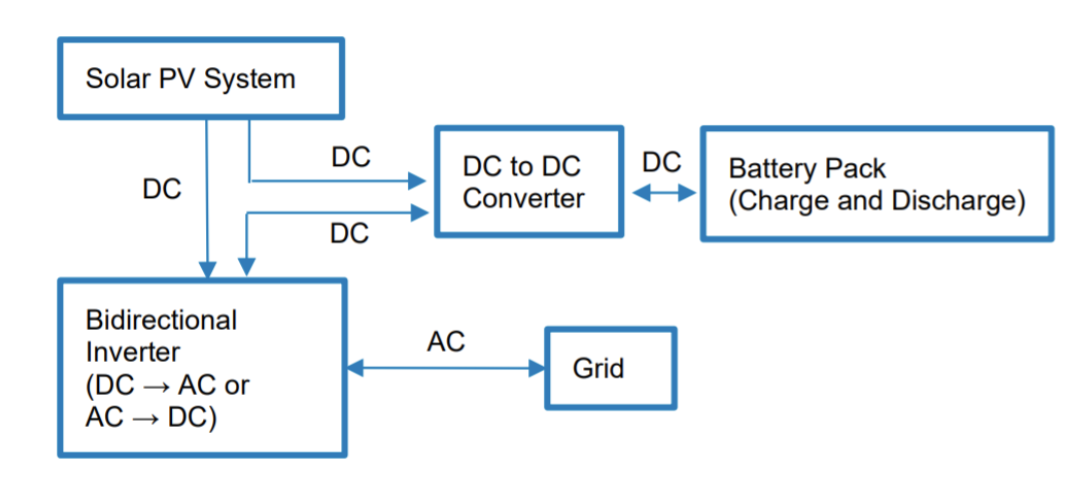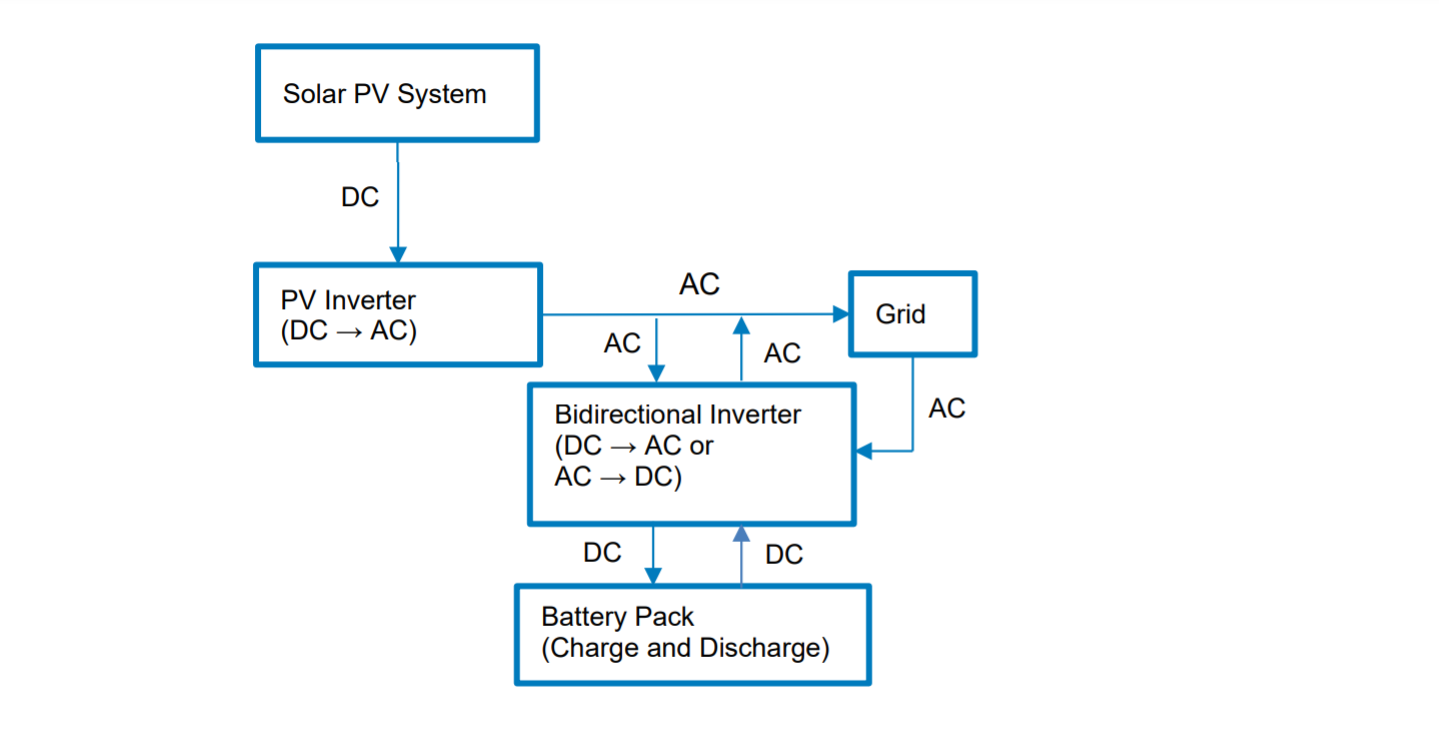Utility-Scale PV-Plus-Battery
2023 ATB data for utility-scale PV-plus-battery are shown above. Details are provided for a single configuration, and supplemental information is provided for related configurations in order to reflect the uncertainty about the dominant architecture for coupled PV and battery systems (now and in the future). Base Year cost estimates rely on modeled capital expenditures (CAPEX) and on operation and maintenance (O&M) costs benchmarked with industry and historical data. Capacity factor is estimated for ten resource classes for the United States - which are binned by mean global horizontal irradiance (GHI) - and it is based on assumptions regarding battery operation. Future year cost projections are derived from bottom-up benchmarking of utility-scale PV-plus-battery CAPEX and bottom-up engineering analysis of O&M costs, and future capacity factor estimates encompass a range of technology innovation scenarios for utility-scale PV and utility-scale battery storage.
Resource Categorization
The PV-plus-battery technology uses the same ten resource categories as the utility-scale PV technology. See the Resource Categorization section of the utility-scale PV page for a description of these ten resource categories.
Scenario Descriptions
Technology innovation scenarios for PV-plus-battery are a combination of standalone utility-scale PV and utility-scale battery technology innovation scenarios (e.g., the Conservative Scenario for PV-plus-battery technology uses the Conservative Scenarios of both standalone utility-scale PV and utility-scale battery technologies). For details, see the scenario descriptions for utility-scale PV and the scenario descriptions for utility-scale battery storage.
Scenario Assumptions
This year scenario assumptions for utility-scale PV plus battery energy storage system (BESS) were derived using the standalone cost projections of PV & battery systems and are not based on learning curves or deployment projections.
For a 130-MWDC PV array, a 78-MWDC nameplate battery (60-MWDC usable with 4-hour duration), and a shared 100-MWAC inverter, the technology-innovation scenarios for utility-scale PV plus BESS described above result in CAPEX reductions of 18% (Conservative Scenario), 36% (Moderate Scenario), and 49% (Advanced Scenario) between 2022 and 2035. The average annual reduction rates are 1.3% (Conservative Scenario), 2.6% (Moderate Scenario), and 3.5% (Advanced Scenario).
Between 2035 and 2050, the CAPEX reductions are 10% (1% per year average) for the Conservative Scenario, 19% (1.3% per year average) for the Moderate Scenario, and 24% (1.6% per year average) for the Advanced Scenario.
Representative Technology
The utility-scale PV-plus-battery technology represents a DC-coupled system (displayed in the figure below), in which one-axis tracking PV and 4-hour lithium-ion battery (LIB) storage share a single bidirectional inverter. The PV-plus-battery technology is represented as having a 130-MWDC PV array, a 78-MWDC battery (60-MWDC usable with 4-hour duration), and a shared 100-MWAC inverter. Therefore, the PV component has a DC-to-AC ratio (or inverter loading ratio [ILR]) of 1.34. After accounting for state-of-charge and roundtrip efficiency constraints, the oversized battery component allows for 240 MWh of usable stored energy. The assumed relative sizing of the PV, battery, and inverter components is consistent with existing (but limited) data for online and proposed utility-scale PV-plus-battery systems - whose inverter characteristics (shared versus separate) are not well known.

Source: (Ramasamy et al., 2021)
The dominant architecture for proposed and future utility-scale PV-plus-battery systems is highly uncertain (Schleifer et al., 2022). Interconnection queue data for most market regions do not include detailed information about inverter characteristics for proposed projects (Bolinger et al., 2021). Moreover, the highest-value architecture will likely evolve over time based on future changes in the grid mix, the performance characteristics of key hybrid components (e.g., bidirectional inverters and DC-to-DC converters), and federal incentives (Schleifer et al., 2022). Within the context of this uncertainty, we choose a DC-coupled configuration for the default utility-scale PV-plus-battery technology because of characteristics that make the coupled system distinct from multiple separate systems, including:
- DC coupling enables operational synergies such as (1) increased round-trip efficiency when the battery charges from the coupled PV and (2) the ability to capture energy that would otherwise be clipped by the inverter or lost due to low-voltage conditions (e.g., during sunrise/sunset and hours with significant cloud cover).
- Cost implications for DC-coupled systems are complex: such systems require only one shared inverter (which presents a cost savings), but they require additional DC-to-DC converters and could require more sophisticated control systems to co-optimize the utilization of both the PV and battery components (which presents a cost increase).
- The design of DC-coupled systems is complex and integrated, largely because the battery racks are distributed throughout the PV field. This leads to a greater number of smaller battery racks and, therefore, higher structural balance of system (BOS), electrical BOS, labor, and O&M costs compared to colocated systems. For example, these distributed battery racks require more individual thermal energy management and fire suppression systems than what would be needed with the larger, centralized battery racks found in colocated systems.
Methodology
This section describes the methodology to develop our reported CAPEX, O&M, and capacity factor values. For assumptions that are standardized for all technologies in the 2023 ATB, see labor cost, regional cost variation, materials cost index, scale of industry, policies and regulations, and inflation.
Utility-scale PV-plus-battery projections are driven primarily by CAPEX cost improvements, along with improvements in energy yield, operating cost, and cost of capital (for the Market + Policies Financial Assumptions Case). For more information, see the Financial Cases and Methods page.
Though CAPEX is one driver of cost reductions over time, R&D efforts continue to focus on other areas to lower the cost of energy from utility-scale PV-plus-battery, such as longer system lifetime and improved performance. Three 2030 projections are developed for scenario modeling as bounding levels:
- Conservative Technology Innovation Scenario (Conservative Scenario): lower levels of R&D investment with minimal technology advancement and current global component pricing
- Moderate Technology Innovation Scenario (Moderate Scenario): R&D investment continuing at similar levels as today, with current industry technology road maps achieved but no substantial innovations or new technologies introduced to the market
- Advanced Technology Innovation Scenario (Advanced Scenario): an increase in R&D spending that generates substantial innovation, allowing historical rates of development to continue.
Capital Expenditures (CAPEX)
The 2023 ATB assumes base year estimates and future projections have fixed component sizing that is consistent with the description in the Representative Technology section of this page. Plant costs are represented with a single estimate per innovation scenario because CAPEX does not correlate well with solar resource availability. All cost values are presented in 2021 real USD.
In general, our cost assumptions for utility-scale PV-plus-battery are rooted in the cost assumptions for the independent utility-scale PV and 4-hour battery storage technologies. Therefore, our primary contribution is to capture the cost factors that are influenced by the coupling of utility-scale PV and battery technologies, including its influence on site preparation, land acquisition, hardware, installation labor, interconnection and permitting costs, and other factors.
Base Year: The Base Year (2021) is based on Q1 2022 costs as reported in (Ramasamy et al., 2022). The 2023 cost estimate is developed using the bottom-up cost modeling method from the National Laboratory of the Rockies's (NLR's) U.S. Solar Photovoltaic System and Energy Storage Cost Benchmarks, With Minimum Sustainable Price Analysis: Q1 2022 (Ramasamy et al., 2022).
The detailed cost information provided is based on our default configuration, which involves an ILR of 1.34 based on the PV component only and an oversized battery component (78-MWDC nameplate capacity to allow for usable power from the battery that is equal to 60-MWDC, or roughly half of the inverter capacity) with 4-hour duration. This default configuration is designed to be consistent with what is known about recent and proposed utility-scale PV-plus-battery projects (Bolinger et al., 2021). However, DC-coupled PV-plus-battery systems are expected to trend toward higher ILRs (and longer-duration batteries) because of the incremental value associated with the recovery of clipped energy and the enhanced capacity credits. Under such a configuration, select cost categories would scale with the size of the PV arrays, which define the ILR; for details, see the Comparison with Alternate Configurations section.
Use the following table to view the components of CAPEX
Future Projections: Future projections of the CAPEX associated with our utility-scale PV-plus-battery technology combine the projections for utility-scale PV and utility-scale battery storage technologies (with 4-hour storage). The technological innovations achieved for utility-scale PV-plus-battery systems (by scenario) are the same as those achieved for standalone utility-scale PV and standalone utility-scale battery systems in the areas of module efficiency, battery packs, inverter power electronics (including bidirectional battery inverters), and installation and hardware BOS efficiency improvements.
| Year | Advanced Scenario (Increased R&D) | Moderate Scenario (Current R&D) | Conservative Scenario (Decreased R&D) |
| 2035 | * $1,326/kWAC | † $1,764/kWAC | $2,311/kWAC |
| 2050 | $1,007/kWAC | * $1,332/kWAC | † $1,928/kWAC |
More-aggressive scenarios reach given CAPEX sooner, as indicated by the asterisks and daggers.
The rated capacity in the denominator is reported in terms of the capacity of the shared central inverter, which sets the maximum AC power output of the plant.
Operation and Maintenance (O&M) Costs
Operation and maintenance (O&M) costs represent the annual fixed expenditures required to operate and maintain a PV-plus-battery plant over its lifetime, and they are rooted in the O&M costs reported for utility-scale PV and utility-scale battery storage technologies. The fixed O&M costs include the annualized cost of replacing the battery in year 15. The cost is based upon replacing 80% of the standalone battery overnight capital cost (OCC), using the OCC value from the same scenario 15 years after the commercial online date. Components included in the replacement include the battery cells and cabinet, labor, and overhead. Inverter replacements are included in the PV portion of the O&M costs.
Variable O&M costs for the battery component are likely to be nonzero because of the cycle degradation typical of LIB storage; however, all our assumed O&M costs are fixed in nature—not variable—which is consistent with those reported for independent battery storage. Items included in O&M costs are noted in the table below.
Capacity Factor
The capacity factor represents the expected annual average energy production divided by the maximum annual energy production if the plant were to operate at rated capacity (the bidirectional inverter capacity in this case) for every hour of the year. Capacity factor is intended to represent a long-term average over the lifetime of the plant; it does not represent interannual variation in PV energy production or in battery charging/discharging behavior based on changing electricity prices. Future year estimates represent the estimated annual average capacity factor over the technical lifetime of a new plant installed in a given year.
The capacity factor of the utility-scale PV-plus-battery system is a function of the capacity factors of the PV and battery components, assuming a certain amount (Y% in the figure below) of the battery energy is charged from the coupled PV. The PV capacity factor is based on the 10 resource categories as described in the capacity factor section of the utility-scale PV page. The battery capacity factor is based on one cycle per day (4 hr/24 hr = 16.7%) as described in the capacity factor section of the utility-scale battery storage page (for a 4-hour duration system). These values, shown in the gray boxes below, are directly tied to independent utility-scale PV and utility-scale battery technologies, and they do not change as a function of the user-defined Y% .
The total energy output is the sum of the PV energy that goes directly to the grid and the battery energy that is discharged to the grid. This total energy output is dictated by the user-defined Y% (i.e., the shares of PV and grid charging), which influences the capacity factor of the utility-scale PV-plus-battery system.
The battery efficiency depends on the source of charging: we assume 85% round-trip efficiency when charging from the grid and 87% efficiency when charging from the coupled PV (because of avoided AC/DC conversions in the latter case) (Schleifer et al., 2022). In the figure below, RTE (round-trip efficiency) refers to the efficiency when charging from the coupled PV. These round-trip efficiency values remain unchanged through 2050.

The energy flows in the above figure are:
- EPV: energy generated by the PV array
- EPV–>G: energy generated by the PV array that is sent directly to the grid
- EPV–>B: energy generated by the PV array that is sent to the battery
- EB: energy discharged from the battery to the grid
- EG–>B: energy charged to the battery from the grid.
The above assumptions result in the following equation for capacity factor:
$$ \text{PV-plus-battery capacity factor (%)} = \text{utility PV capacity factor (%)} \;+ $$
$$ \text{4-hour battery storage capacity factor (%)} \times \frac{\text{battery nameplate (MW)}}{ \text{inverter nameplate (MW)}}\times $$
$$ \left[1 - \frac{\text{percentage of energy from PV (%, } \boldsymbol{Y(\%)} \text{ above)}} { \text{RTE PV to battery (%)}}\right] $$
Finally, a benefit of DC-coupling is the PV-plus-battery system's ability to use energy that would otherwise be lost in the absence of the DC-coupled battery (i.e., energy clipped by the inverter during times when the DC power from the PV array exceeds the rating of the inverter). However, the figure below indicates the amount of clipped energy for our representative technology is 0.0%–0.5% of the DC electricity produced by the PV array in most of the contiguous United States. Therefore, we assume the increase in capacity factor that is due to the DC-coupled system's ability to capture otherwise clipped energy is negligible for our representative technology, but we discuss the greater potential for capacity factor increases in systems with increasing ILRs in the Comparison with Alternate Configurations section below.

Source: (Eurek et al., 2021)
Impacts of Grid Charging on LCOE
The LCOE of our DC-coupled PV-plus-battery technology is rooted in the CAPEX costs, O&M costs, and capacity factor descriptions above. It also depends on the user-defined Y% (default of 75%), which influences both the capacity factor and operating costs.
The default LCOE calculation includes a grid charging cost of $23/MWh, which is an average applied to all scenarios and years. This is based on taking a generation-weighted average of the lowest-cost hour of each day in each balancing area in the 2022 Cambium data set for the contiguous United States, inflated to 2021$. However, grid charging costs will likely be lower in locations and years with higher deployment of variable renewable energy technologies, as they will likely see higher levels of curtailment (Jorgenson et al., 2022). In the ATB Spreadsheet, users can insert a static, average cost of grid charging that is unchanged over time and location. Every $10/MWh increase in this average grid charging cost increases the LCOE by approximately $3/MWh, assuming 25% of the battery's energy comes from the grid and a round-trip efficiency of 85% (25% * $10/MWh / 85% = $2.94/MWh).
While the LCOE of our utility-scale PV-plus-battery technology is informative on its own, a comparison with the LCOE for utility-scale PV provides insights into the incremental value associated with DC coupling. The observed difference in LCOE between utility-scale PV-plus-battery and utility-scale PV technologies (for a given year and resource bin) is roughly in-line with empirical power purchase agreement price data for PV-plus-battery systems with comparable battery sizes (Bolinger et al., 2021). However, it is important to note there are inherent differences between LCOE and power purchase agreement price metrics, as the latter is influenced by factors that are not strictly based on costs or energy production (such as capacity payments, renewable energy certificates, and strategic bidding).
Comparison with Alternate Configurations
The dominant architecture and component sizing for utility-scale PV-plus-battery technologies are highly uncertain for both proposed and future projects (Schleifer et al., 2022). Therefore, we provide users with a high-level cost and performance comparison for alternative PV-plus-battery configurations, including a DC-coupled PV-plus-battery configuration with a higher ILR and considerations for an AC-coupled PV-plus battery configuration.
DC-coupled PV-plus-battery systems with higher ILRs will have higher total energy output because of the additional (DC) capacity of the PV array; without a DC-coupled battery, this additional energy would be clipped by the inverter, as shown in the figure below. An ILR of 1.7 can lead to capacity factor increases of 6 to 10 percentage points over the representative system, depending on the degree of grid charging. Additional details for capacity factors with higher ILRs can be found in (Schleifer et al., 2022).

Applying the same bottom-up cost modeling method to a DC-coupled PV-plus-battery system with an ILR of 1.7 (with the remaining component sizes being fixed), the total cost increases because of higher PV module, electrical and structural BOS, labor, and other soft costs. In an AC-coupled configuration, the PV and battery components operate through separate inverters. This difference has important implications for non-inverter cost categories, as it influences the design, layout, and complexity associated with project installation, with details in the figure below.

Source: (Ramasamy et al., 2021)
Adapted from: (Ramasamy et al., 2021)
An AC-coupled system would have a lower charging efficiency than our default DC-coupled configuration because of the multiple AC/DC conversions required to charge the battery component from either the coupled PV or the grid. The round-trip efficiency for any charging source would be equivalent to that of our default DC-coupled configuration when charging from the grid (85%), which is slightly lower than that of our default DC-coupled configuration when charging from the coupled PV (87%).
References
The following references are specific to this page; for all references in this ATB, see References.